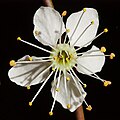Prunus cerasifera
| Prunus cerasifera | |
|---|---|

| |
| Scientific classification | |
| Kingdom: | Plantae |
| Clade: | Tracheophytes |
| Clade: | Angiosperms |
| Clade: | Eudicots |
| Clade: | Rosids |
| Order: | Rosales |
| Family: | Rosaceae |
| Genus: | Prunus |
| Subgenus: | Prunus subg. Prunus |
| Section: | Prunus sect. Prunus |
| Species: | P. cerasifera
|
| Binomial name | |
| Prunus cerasifera Ehrh. 1784 not Popov 1929 nor Lecoq & Lamotte 1848
| |
| Synonyms[2] | |
|
List
| |
Prunus cerasifera is a species of plum known by the common names cherry plum and myrobalan plum.[3] It is native to Southeast Europe[4][5][6] and Western Asia,[3][7] and is naturalised in the British Isles[4] and scattered locations in North America.[8][9][10] Also naturalized in parts of SE Australia where it is considered to be a mildly invasive weed of bushland near urban centers. P. cerasifera is believed to one of the parents of the cultivated plum, Prunus domestica perhaps crossing with the sloe, Prunus spinosa,[11] or perhaps the sole parent.[12] This would make it a parent of most of the commercial varieties of plum in the UK and mainland Europe - Victoria, greengages, bullace etc.
Description
[edit]Wild types are large shrubs or small trees reaching 8–12 m (25–40 feet) tall, sometimes spiny, with glabrous, ovate deciduous leaves 3–7 cm (1–3 in) long.[4]: 196 It is one of the first European trees to flower in spring,[4] often starting in mid-February before the leaves have opened. The flowers are white or pale pink and about 2 cm (3⁄4 in) across, with five petals and many stamens. The fruit is an edible drupe, 2–3 cm in diameter, ripening to yellow or red from early July to mid-September. They are self-fertile but can also be pollinated by other Prunus varieties such as the Victoria plum.[13] The plant propagates by seed or by suckering, and is often used as the rootstock for other Prunus species and cultivars.[4]
Cultivation
[edit]The cherry plum is a popular ornamental tree for garden and landscaping use, grown for its very early flowering. Numerous cultivars have been developed, many of them selected for purple foliage, such as P cerasifera var pissardii (Carrière) L.H. Bailey (P. 'Atropurpurea').[4][14] The cultivar 'Nigra' with black foliage and pink flowers, has gained the Royal Horticultural Society's Award of Garden Merit.[15] Prunus × cistena (purple leaf sand cherry), a hybrid of Prunus cerasifera and Prunus pumila, the sand cherry, also won the Award of Garden Merit.[16] [17][18] These purple-foliage forms (often called 'purple-leaf plum'), also have dark purple fruit, which make an attractive, intensely coloured jam. They can have white or pink flowers. The cultivar 'Thundercloud' has bright red foliage which darkens purple.[19] Others, such as 'Lindsayae', have green foliage. Some kinds of purple-leaf plums are used for bonsai[14] and other forms of living sculpture.
Cultivated cherry plums can have fruits, foliage, and flowers in any of several colours. Some varieties have sweet fruits that can be eaten fresh, while others are sour and better for making jam. Cherry plums are a key ingredient in Georgian cuisine where they are used to produce tkemali sauce, as well as a number of popular dishes, such as kharcho soup and chakapuli stew. It is a popular tree in Romania where its fruits are used for souring soups when immature, for eating raw when ripened, and for making moonshine when overripe because of their high sugar content.[citation needed]
Gallery
[edit]-
Prunus cerasifera
-
Ripened fruits of Prunus cerasifera on the branch
-
Prunus cerasifera flowers being pollinated
-
Ripened fruits of Prunus cerasifera
-
Prunus cerasifera flowers
-
Prunus cerasifera bonsai (shohin size)
-
Prunus cerasifera flower (close-up)
See also
[edit]- Prunus mahaleb
- Cotoneaster nummularius
- Aria edulis
- Rosa canina
- Pyrus elaeagrifolia
- Malus sylvestris
- Crataegus monogyna
- List of plum dishes
References
[edit]- ^ Kell, S.P. & Wilson, B. (2018). "Prunus cerasifera". IUCN Red List of Threatened Species. 2018: e.T172162A19401052. Retrieved 1 May 2024.
- ^ "Prunus cerasifera Ehrh". Plants of the World Online. Royal Botanic Gardens, Kew. Retrieved 1 March 2024.
- ^ a b UConn Horticulture Archived 14 April 2010 at the Wayback Machine
- ^ a b c d e f Stace, C. A. (2010). New Flora of the British Isles (Third ed.). Cambridge, U.K.: Cambridge University Press. ISBN 9780521707725.
- ^ Altervista Flora Italiana, Prunus cerasifera Ehrh. includes photos and European distribution map
- ^ "UC/JEPS: Jepson Manual treatment for Prunus cerasifera". berkeley.edu.
- ^ Flora of China, Prunus cerasifera Ehrhart, 1789. 樱桃李 ying tao li
- ^ Flora of North America, Prunus cerasifera Ehrhart, 1784. Cherry plum, myrobalan
- ^ "University of Washington Herbarium Image Collection - Burke Museum". washington.edu. Archived from the original on 2015-06-27.
- ^ "Calflora taxon report, University of California: Prunus cerasifera". calflora.org.
- ^ "All about plums – Juicy facts of Prunus domestica". Garden Museum. Retrieved 1 March 2024./
- ^ "Is the European plum, Prunus domestica L., a P. cerasifera EHRH. x P. spinosa L. allo-polyploid?". Springer Nature. Retrieved 1 March 2024.
- ^ Titmarsh, Alan (2008). The Kitchen Gardener. BBC Books. p. 247.
- ^ a b Pissard Plum Fact Sheet
- ^ "RHS Plant Selector Prunus cerasifera 'Nigra' AGM / RHS Gardening". Apps.rhs.org.uk. Retrieved 22 February 2020.
- ^ "Prunus × cistena". RHS. Retrieved 18 February 2019.
- ^ Plant Facts, Prunus x cistena - Purpleleaf Sand Cherry (Rosaceae)
- ^ Nazareth College, Purpleleaf Sand Cherry Prunus x cistena Archived 2016-03-06 at the Wayback Machine/
- ^ Thundercloud Fact Sheet
External links
[edit]- "Prunus cerasifera". Plants for a Future.
- "Prunus cerasifera divaricata". Plants for a Future.
- Prunus cerasifera in the CalPhotos photo database, University of California, Berkeley
- Prunus cerasifera - information, genetic conservation units and related resources. European Forest Genetic Resources Programme (EUFORGEN)








